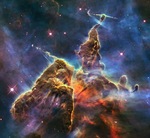[Fe II] Emission Tracing Dense Jets for Intermediate-Mass Protostars in Carina
| Date/Time: | Friday, 29 Mar 2013 from 4:10 pm to 5:00 pm |
|---|---|
| Location: | Room 3 |
| Contact: | Massimo Marengo |
| Phone: | 515-294-2958 |
| Channel: | College of Liberal Arts and Sciences |
| Actions: | Download iCal/vCal | Email Reminder |
We present narrowband WFC3-UVIS and -IR images of four externally irradiated protostellar jets in the Carina nebula: HH 666, HH 901, HH 902, and HH 1066. These massive jets are unusual because they are bathed in UV radiation from dozens of nearby O-type stars, but despite the strong incident ionizing radiation, portions of the jet remain neutral. Near-IR [Fe II] images reveal this dense, neutral gas that was not seen in previous studies of Hα emission. We show that near-IR [Fe II] emitting gas must be self-shielded from Lyman continuum photons, regardless of its excitation mechanism (shocks, FUV radiation, or both). High densities are required for the survival of Fe+ amid the strong Lyman continuum luminosity from Tr14, raising estimates of the mass-loss rates by an order of magnitude. Higher jet mass-loss rates require higher accretion rates onto their driving protostars, implying that these jets are driven by intermediate-mass (~2 - 8 Mo) stars. Indeed, the IR driving sources of two of these outflows have luminosities that require intermediate-mass protostars. We propose that these jets reflect essentially the same outflow phenomenon seen in wide-angle molecular outflows associated with intermediate- and high-mass protostars, but that the collimated atomic jet core is irradiated and rendered observable in the harsh radiative environment of the Carina nebula. In more quiescent environments, this atomic core remains invisible, and outflows traced by shock-excited molecules in the outflow cavity give the impression that these outflows have a wider opening angle. Thus, the externally irradiated jets in Carina constitute a new view of collimated jets from intermediate-mass protostars, and offer strong additional evidence that stars up to at least ~8 Mo form by the same accretion mechanisms as low-mass stars.
